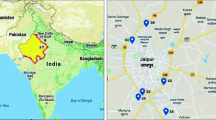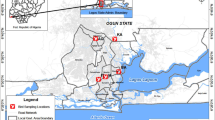Abstract
The objective of the study was to assess the heavy metal contamination in excreta of the Baya Weaver Bird (Ploceus philippinus). Samples were collected from nesting colony sites present in three districts viz. Ludhiana (location I), Ropar (location II) and Ferozepur (location III) falling in Central plain zone, Undulating plain zone and Western plain zone of Punjab respectively. In dry excreta samples fifteen elements were detected through ICAP-AES; As, Pb, Cd, Cr were toxic heavy metals and B, Fe, Cu, Ni, Zn, Mn, Mg, Ca, P, S, Na were essential elements. Toxic heavy metals viz. As (1.88–2.10 ppm), Pb (2.70- 5.25 ppm) and Cr (13.30–23.78 ppm) were found above normal range in excreta collected from studied locations. Statistical analysis showed significant difference among heavy metals and locations which signifies the bioaccumulation of different metals at different locations in excreta of Baya Weaver Bird due to different type of contaminations at studied locations.
Similar content being viewed by others
References
Ahmad W, Zia MH, Malhi SS, Saifullah NA (2012) BoronDeficiencyinSoilsandCrops:A Review. In: Goyal A (ed) Crop Plant. InTech publishers, London, pp 77–114
Ansara-Ross TM, Ross MJ, Wpener V (2013) The use of feathers in monitoring bioaccumulation of metals and metalloids in the south African endangered African grass-owl (Tyto capensis). Ecotoxicology 22:1072–1083
Baker NJ, Dahms S, Gerber R, Maina J, Greenfield R (2017) Metal Accumulation in House Sparrow (Passer domesticus) from Thohoyandou, Limpopo Province. South Africa J Afr Zool 52(1):43–53
Bannon DI, Drexler JW, Fent GM, Casteel SW, Hunter PJ, Brattin W (2009) Evaluation of small arms range soils for metal contamination and lead bioavailability. Environ Sci Technol 43:9071–9076
Berglund AM (2018) Evaluating blood and excrement as bioindicators for metal accumulation in birds. Environ Pollut 233:1198–1206
Berglund AMM, Rainio MJ, Eeva T (2015) Temporal trends in metal pollution: Using Bird excrement as Indicator. PLoS ONE 10(2):e0117071
Bianchi N, Ancora S, Fazio ND, Leonzio C (2008) Cadmium, Lead and Mercury levels in Feathers of small passerine birds: Noninvasive sampling strategy. Environ Toxicol Chem 27(10):2064–2070
Bricka RM, Williford CW, Jones LW (1994) Heavy Metal Soil Contamination at U.S. Army Installations: Proposed Research and Strategy for Technology Development. Installation Restoration Research Program VII series: Technical Report (U.S. Army Engineer Waterways Experimnent Station); IRRP-94–1.
Canny CJ, Pollock CG (2000) Avian endocrinology. In: Olsen GH, Orosz SE (eds) Manual of avian medicine. Mosby, St. Louis, Missouri, pp 313–358
Chrastny V, Michael K, Hajek T (2010) Lead contamination of an agricultural soil in the vicinity of a shooting range. Environ Monit Assess 162:37–46
Dauwe T, Bervoets L, Pinxten R, Blust R, Eens M (2004) Variation of heavy metals within and among feathers of birds of prey: Effects of molt and external contamination. Environ Pollut 124:429–436
Dauwe T, Janssens E, Pinxten R, Eens M (2005) The reproductive success and quality of blue tits (Parus caeruleus) in a heavy metal pollution gradient. Environ Pollut 136:243–251
Dhindsa MS, Toor HS (1980) Extent of bird damage to rice nurseries in the Punjab and its control. Indian J Agric Sci 50:715–719
Drever JI (1997) The geochemistry of natural water: surface and groundwater environments, 3rd edn. Prentice Hall, New Jersey
Durand M (2007) Toxic gases and dead birds at Sulphur Bay, Rotorua, North Island, New Zealand. Notornis 54:42–44
Eeva T, Raivikko N, Espin S, Sanchez-Virosta P, Ruuskanen SJ, Rainio M (2020) Bird feces as indicators of metal pollution: Pitfalls and solutions. Toxics. https://doi.org/10.3390/toxics8040124
Ertani A, Schiavon M, Nardi S (2017) Transcriptome-wide identification of differentially expressed genes in Solanum lycopersicon L. in response to an alfalfa-protein hydrolysate using microarrays. Front Plant Sci 8:1159
Hashmi MZ, Malik RN, Shahbaz M (2013) Heavy metals in eggshells of cattle egret (Bubulcus ibis) and little egret (Egretta garzetta) from the Punjab province, Pakistan. Ecotoxicol Environ Saf 89:158–165
Kaur N, Dhanju CK (2013) Heavy metal concentration in excreta of free living wild birds as indicator of environmental contamination. The Bioscan 8(3):1089–1093
Kaur T, Sharma K, Sinha AK (2014) Industrial pollution in the sub-soil water and its health effects: a preliminary study around Buddha Nullah, Punjab. In: Sharma K, Sinha AK (eds) Human ecology in an era of globalization and urbanization. Serial Publications, New Delhi, pp 267–282
Khushwaha S (2016) Heavy Metal Concentrations in Feathers of Critically Endangered Long-Billed Vultures (Gyps Indicus) in Bundelkhand Region. India Int J LifeSci Res 2(4):365–375
Kitowski I, Sujak A, Wiącek D, Strobel W, Komosa A, Stobinski M (2016) Heavy metals in livers of raptors from Eastern Poland – the importance of diet composition. Belg J Zool 146(1):3–13
Kler TK, Parshad RK (2011) Bird composition in relation to phenological stages of wheat and rice crops. Agric Res J 48:163–171
Kler TK, Vashishat N, Kumar M (2014) Heavy metal contamination in excreta of avian species from Ludhiana district of Punjab. Int J Adv Res 2(7):873–879
Kler TK, Vashishat N, Kumar M (2018) Chemical composition of excreta of Blue Rock Pigeon (Columba livia) from urban niches of agricultural region. Agric Res J 55(3):602–605
Kunito T, Kubota R, Fujihara J, Agusa T, Tanabe S (2008) Arsenic in marine mammals, seabirds, and sea turtles. Rev Environ Contam Toxicol 195:31–69
Malik RN, Zeb N (2009) Assessment of environmental contamination using feathers of Bubulcus ibis as a biomonitor of heavy metal pollution, Pakistan. Ecotoxicology 18:522–536
Nwaedozie G, Mohammed Y, Faruruwa DM, Nwaedozie JM (2013) Environmental Impact of Toxic Metal Load in Some Military Training Areas within the One Division of Nigerian Army, Kaduna, Nigeria. Int J Acad Res Busi Soc Sci 3:2222–6990
Panagos P, Ballabio C, Lugato E, Jones A, Borrelli P, Scarpa S, Orgiazzi A, Montanarella L (2018) Potential Sources of Anthropogenic Copper Inputs to European Agricultural Soils. Sustainability 10:2380
Pannu KK, Kler TK (2018) Heavy metal contamination in excreta of House sparrow (Passer domesticus) from rural areas of Ludhiana. J Entomol Zool Stud 6(1):77–81
PPCB proceedings (2016) Implementation of action plan for abatement of pollution in critically polluted area of Ludhiana and Mandi Gobindgarh. pp.1–50.
Prakash D, Singh P, Khurana MPS (2014) Deficiency and Amelioration of Micro- Nutrients in Rice- Wheat Cropping System. Popular Kheti 2(2):82–84
Sadana US, Manchanda JS, Khurana MPS, Dhaliwal SS, Singh H (2010) The current scenario and efficient management of Zinc, Iron and Manganese deficiencies. Better Crop- South Asia 4(1):24–26
Scheifler R, Coueudassier M, Morillhat C, Bernard N, Faivre B, Flicoteaux P, Giraudoux P, Nouel M, Piotte P, Rieffel D, de Vanfleury A, Badot PM (2006) Lead concentrations in feathers and blood of common blackbirds (Turduc merula) and in earthworms inhabiting the unpolluted and moderately polluted urban areas. Sci Total Environ 371:197–205
Setia R, Sharma KN, Marschner P, Singh H (2009) Changes in Nitrogen, Phosphorus, and Potassium in a Long-Term Continuous Maize-Wheat Cropping System in India. Commun Soil Sci Plant Anal 40(21–22):3348–3366
Sharma R, Dutta A (2017) A study of Heavy Metal Pollution in Groundwater of Malwa Region of Punjab: Current Status, Pollution and its Potential Health Risk. Int J Eng Res Appl 7(3):81–91
Sharma S, Nagpal AK, Kaur I (2018) Heavy metal contamination in soil, food crops and associated health risk for residents of Ropar wetland, Punjab, India and its environs. Food chem 255:15–22
Sidhu GPS (2016) Heavy metal toxicity in soils: sources, remediation technologies and challenges. Adv Plants Agric Res 5(1):445–446
Sidhu GS, Kumar D (2018) Influence of soil applied Boron on yield of barseem (Trifolium alexandrium L.) and soil boron fractions in calcareous soils. J Plant Nutri. https://doi.org/10.1080/01904167.2018.1431667
Stanley TR, Smith GJ, Hoffman DJ, Heinz GH, Rosscoe R (1996) Effects of boron and selenium on mallard reproduction and duckling growth and survival. Environ Toxicol Chem 15:1124–1132
Tchounwou PB, Yedjou CG, Patlolla AK, Sutton DJ (2012) Heavy metal toxicity and environment. Springer 101:133–164
Acknowledgement
The authors are extremely grateful to the Head, Department of Zoology and Head, Department of Soil Sciences, Punjab Agricultural University for providing necessary facilities to carry out this work.
Author information
Authors and Affiliations
Corresponding author
Additional information
Publisher’s note
Springer Nature remains neutral with regard to jurisdictional claims in published maps and institutional affiliations.
Rights and permissions
About this article
Cite this article
Sidhu, S.K., Kler, T.K. Assessment of Heavy Metal Contamination in Excreta of Baya Weaver Bird (Ploceus Philippinus) from Three Districts of Different Zones of Punjab. Bull Environ Contam Toxicol 106, 799–804 (2021). https://doi.org/10.1007/s00128-021-03181-z
Received:
Accepted:
Published:
Issue Date:
DOI: https://doi.org/10.1007/s00128-021-03181-z




